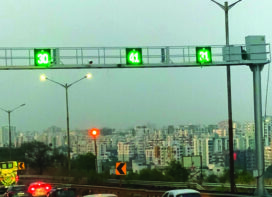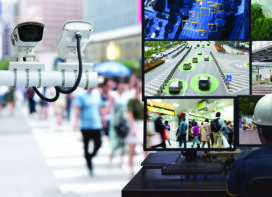“Every 20 minutes, as part of the Public Address System, information on the general parking and premium parking areas, the way to follow signs and make payments is provided through an automatic voice communication system,” says Alam.
The parking is done by the customers themselves as the guidance system is self- explanatory but guards are stationed on  each floor to guide them nevertheless. After parking, the motorist walks up to the pay booths, shows his ticket and makes the payment. Validators are installed at each entry point that convert the payment into premium payment if the motorist pays at the general parking and then comes to premium parking area. “If he has to enter ground or second floor, he has to get his entry validated into premium entry,” says Tejvir Singh, Project Manager of FAAC India stationed at Terminal 3.
each floor to guide them nevertheless. After parking, the motorist walks up to the pay booths, shows his ticket and makes the payment. Validators are installed at each entry point that convert the payment into premium payment if the motorist pays at the general parking and then comes to premium parking area. “If he has to enter ground or second floor, he has to get his entry validated into premium entry,” says Tejvir Singh, Project Manager of FAAC India stationed at Terminal 3.
SADS
 An important feature of the Parking System at the terminal is the Safety Loop which includes a Space Availability Display System (SADS) designed and developed by FAAC India using automation help from Horizon (the Schneider Electric integrator). “For parking guidance system, we partnered with Schneider but it was not in the front and we had complete control over the system and operations. Though every product was chosen and manufactured by us, we took their help in integration,” says Tyagi.
An important feature of the Parking System at the terminal is the Safety Loop which includes a Space Availability Display System (SADS) designed and developed by FAAC India using automation help from Horizon (the Schneider Electric integrator). “For parking guidance system, we partnered with Schneider but it was not in the front and we had complete control over the system and operations. Though every product was chosen and manufactured by us, we took their help in integration,” says Tyagi.
The monitoring of the cars is round the clock. In the control room (CR) of FAAC India at MLCP, to which only FAAC employees associated with the project have access, different computers monitor the various aspects of the parking area. Every car entering or exiting, the occupancy of every bay and the position of every car or person get reflected in the control room. Cameras are installed at all the entry points that capture the number plates of each vehicle entering the parking lot through Licence Plate Reader (LPR) system. That gets stored in the database and finds its way to the control room. The control room has a computer each for LPR System, space availability and the display system. At any given point of time, SADS can show the real-time details of total vacancy, total capacity, total occupancy and the break-up of each. “At the click of a  button, the engineer gets the status of parked cars on each floor. The yellow colour on each car on the computer shows the availability of the slot while red means the bays are occupied. A click on any car will give details in a pop-up box on the car’s bay, time of parking etc. On the computer itself, you can zero in on the number plate of any car you want to check. This is thanks to SADS that was developed and customised for MLCP in a record time,” says Singh. The real-time data is available with FAAC round the clock and can be accessed by Delhi Airport Parking Services (DAPS) if required.
button, the engineer gets the status of parked cars on each floor. The yellow colour on each car on the computer shows the availability of the slot while red means the bays are occupied. A click on any car will give details in a pop-up box on the car’s bay, time of parking etc. On the computer itself, you can zero in on the number plate of any car you want to check. This is thanks to SADS that was developed and customised for MLCP in a record time,” says Singh. The real-time data is available with FAAC round the clock and can be accessed by Delhi Airport Parking Services (DAPS) if required.
MLCP, initiated in 2008, is now managed by DAPS with a support staff and engineers of FAAC stationed at the parking office 24/7 to meet any emergency that may arise because of damages caused by customers while entering or exiting the parking bay or while taking out or keeping luggage and also by the ticket getting jammed in the machine.
 The parking system at work at Terminal 3 is Paragon Parking System, a speciality of FAAC. It provides professional management of a modern car park with access to a ground only, or multi level car park, control of vehicle flows and manual and automatic payment modes along with accounting and administrative statements. Its highlights are a “single ticket column for entry and exit, a single it slot for inserting means of transit (tickets and cards), a user interface with alphanumeric display, an optional graphic display, user assistance through intercom and the use of vocal synthesis which is optional.” The unique point of the Paragon Parking System is a module that can be used both manually and in an automatic manner for entry, exit manual or automatic cash payments, etc and can use a wide range of means of transit like barcode tickets, magnetic tickets, magnetic cards, chip cards, proximity cards, and long distance transponders. It also supplies accounting and administrative statements.
The parking system at work at Terminal 3 is Paragon Parking System, a speciality of FAAC. It provides professional management of a modern car park with access to a ground only, or multi level car park, control of vehicle flows and manual and automatic payment modes along with accounting and administrative statements. Its highlights are a “single ticket column for entry and exit, a single it slot for inserting means of transit (tickets and cards), a user interface with alphanumeric display, an optional graphic display, user assistance through intercom and the use of vocal synthesis which is optional.” The unique point of the Paragon Parking System is a module that can be used both manually and in an automatic manner for entry, exit manual or automatic cash payments, etc and can use a wide range of means of transit like barcode tickets, magnetic tickets, magnetic cards, chip cards, proximity cards, and long distance transponders. It also supplies accounting and administrative statements.
Alam informs: “The specific configuration at Terminal 3 includes 11 rapid barriers for the six entries and five exits, 11 ticket columns and 14 manual cash desks. There are two servers with RAID for the IT infrastructure that are located in the control room. While one is used for lane control, the other is utilised for reporting and setup.”
The movement of the cars for parking is via ramps. From the entry, every ramp has two leads – one to each floor while the other forks out towards the top floor. So, the motorist has ample chance to decide whether he wants to opt for premium parking or general parking.
 The general parking charges for the first, third, fourth and fifth floors are र50 for half an hour, र100 for two hours and then, र50 for every one hour up to eight hours going up to र600 for 24 hours. For premium parking on ground and second floors, the charges are र70 for half an hour, 140 for two hours and र70 for every extra hour. Informs Singh, “One man paid र50,000 for parking his car here for an entire month – in January 2011.” For the loss of ticket, the motorist is charged र1000. The payment is always in cash, though the system can handle other modes of payment too, and is made to the cashiers at the payment booths on each floor. The motorist has to alight from the car and pay and has to leave the terminal within 15 minutes of making the payment.
The general parking charges for the first, third, fourth and fifth floors are र50 for half an hour, र100 for two hours and then, र50 for every one hour up to eight hours going up to र600 for 24 hours. For premium parking on ground and second floors, the charges are र70 for half an hour, 140 for two hours and र70 for every extra hour. Informs Singh, “One man paid र50,000 for parking his car here for an entire month – in January 2011.” For the loss of ticket, the motorist is charged र1000. The payment is always in cash, though the system can handle other modes of payment too, and is made to the cashiers at the payment booths on each floor. The motorist has to alight from the car and pay and has to leave the terminal within 15 minutes of making the payment.
Training of employees and live testing
The airport employees who operate the parking underwent rigorous training in English and Hindi. They included 140 cashiers (for working shifts to cover 24 hours of the day), 20 cash supervisors, three system administrators and other staff. As the deadline was tight, FAAC also printed a small booklet for the cashiers to refer to while operating the software initially. The parking system was open to public only after rigorous live testing in various.
Says the DIAL spokesperson, “Given the scale of deployment, we have had a few challenges at the start. However FAAC has supported well and now the systems have streamlined ensuring a smooth operation for the MLCP.”
 TrafficInfraTech Magazine Linking People Places & Progress
TrafficInfraTech Magazine Linking People Places & Progress


